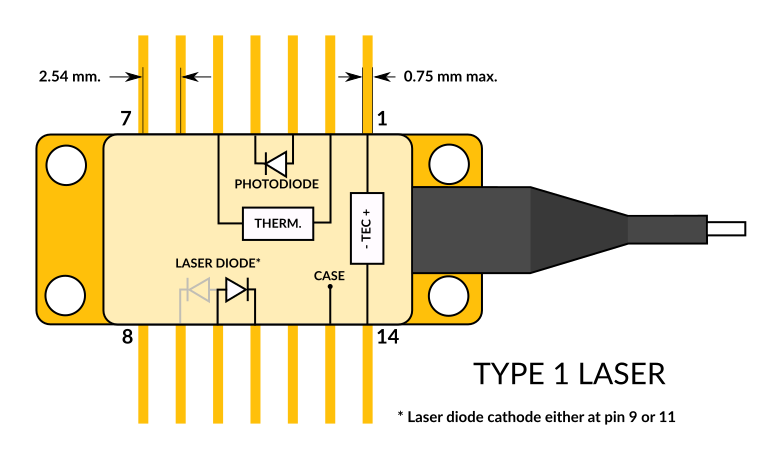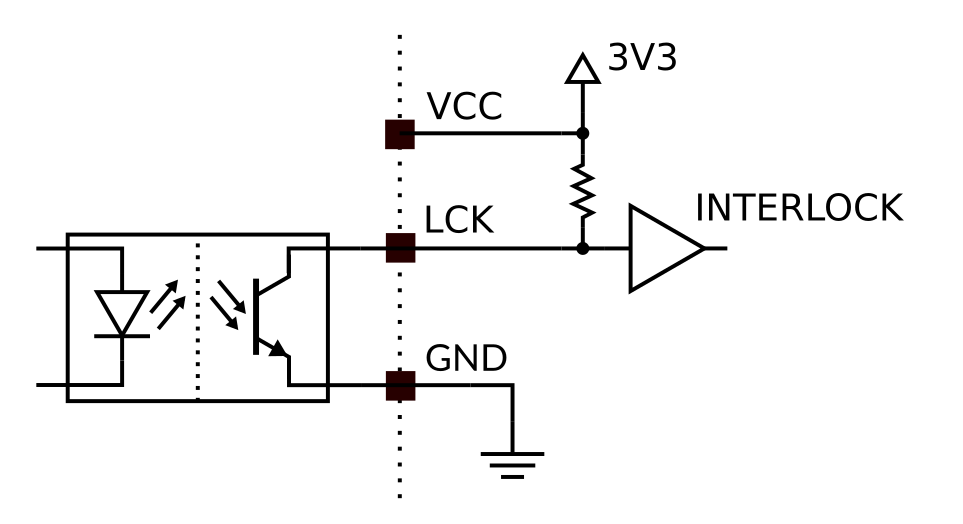
Laser connections
The CTL200-1 / CTL200-2 is compatible with Type 1 / Type 2 butterfly laser diodes. Note that it is compatible with floating diodes.


Terminal block connections
Information related to the terminal block connections can be found on the CTL200-0 user guide.
Power supply
The board must be supplied with the 5.9 V / 3 A power supply that comes with the CTL200. Another power supply can be used, as long as the voltage is between 5.7 V and 6.5 V.
Serial interface
The serial interface can be accessed either via the micro USB connector or via the TX and RX pins of the programming header.

Logic voltage is 3V3, provided on pin 8 of the programming header.
The serial interface is the only way to configure the CTL200 operating parameters. Once the configuration is done, it can be saved to the internal memory with the save command. If the configuration switch SW1 is ON at start up, the CTL200 will load the user-defined configuration and the serial interface is no longer needed.
The CTL200 can be controlled directly from a serial port terminal (e.g. Teraterm on Windows) with the following configuration:
- Baud rate: 115200
- Parity: None
- Bits: 8
- Stopbits: 1
- Flow control: None
Example use of the serial port terminal
>>
>>version
V0.1
>>rtset
10000.000000
>>rtact
10000.023438
>>rtset 12000
12000.000000
>>rtact
11999.853516
Note: Each command must be followed by \r\n.
Graphical User Interface
A Graphical User Interface is available for Windows OS. The installer can be downloaded at this link. The GUI provides an effective mean of tuning the PID gains of the temperature controller.

Control commands
lason: Should be set to 1 to enable the laser current (default value: 0)
tecon: Should be set to 1 to enable the TEC current (default value: 1)
ilaser: Laser current in mA (default value: 0.0).
rtset: Thermistor resistance setpoint in Ω (default value: 10000.0).
pgain: Proportional gain of the temperature controller (default value: 0.001).
igain: Integral gain of the temperature controller (default value: 0.0001).
dgain: Differential gain of the temperature controller (default value: 0.005).
tprot: Should be set to 1 to enable the temperature protection (default value: 1)
rtmin: Minimum thermistor resistance in Ω. If the temperature protection is enabled, the laser current is automatically disabled below this value (default value: 5000.0).
rtmax: Maximum thermistor resistance in Ω. If the temperature protection is enabled, the laser current is automatically disabled above this value (default value: 15000.0).
vtmin: Minimum TEC voltage in V (default value: -2.0).
vtmax: Maximum TEC voltage in V (default value: 2.0).
lckon: Should be set to 1 to enable the interlock functionality (default value: 0)
Status commands
version: Return the firmware version (e.g. V0.1)
lason: Laser status (0 when disabled, 1 when enabled)
vlaser: Laser voltage in V.
iphd: Photodiode current in mA (maximum value: 2.5 mA).
rtact: Actual value of the thermistor resistance in Ω.
itec: TEC current in A.
vtec: TEC voltage in V.
ain1: Voltage on pin AI1 in V.
ain2: Voltage on pin AI2 in V.
status: Return lason, vlaser, itec, vtec, rtact, iphd, ain1 and ain2 in a single command.
Configuration switch
- Switch 1: When SW1 is ON, the user configuration is loaded at start-up. When SW1 is OFF, the default configuration is loaded at start up.
- Switch 2: SW2 is used for firmware update. It should be kept OFF for normal operation.
Status LEDs
- STATUS: Always ON during normal operation
- LASER: Turns ON when the photodiode current is above 10 µA.
- TEMP: Turns ON when the thermistor resistance is within 1 Ω of the setpoint.
The digital outputs DO1 and DO2 replicate the status of LASER and TEMP LEDs on a 3V3 logic level.
Modulation inputs
The CTL200 has two current modulation inputs available on SMA connectors:
DC modulation input for modulation between DC and 10 MHz. Modulation range is ±1 V. A jumper allows to choose between 3 modulation gains (250 µA/V, 2.5 mA/V or 25 mA/V for the 200 mA version).
AC modulation input for modulation above 100 kHz. Modulation range is ±5 V. Modulation gain is 20 mA/V.
Thermal management
The TEC voltage limits (vtmin and vtmax) and the thermistor resistance limits (rtmin and rtmax) provide an effective way of protecting the laser against thermal runaway. For reliable operation, the aluminium cooling base plate must be properly heatsunk.
Interlock
An optional interlock functionality can be activated with the lckon command. Laser current is then disabled when the LCK pin is pulled low. The figure below shows the use of the interlock with an external opto-isolator:

Once laser current has been disabled, the serial command lason 1 must be sent to re-enable the laser current.

